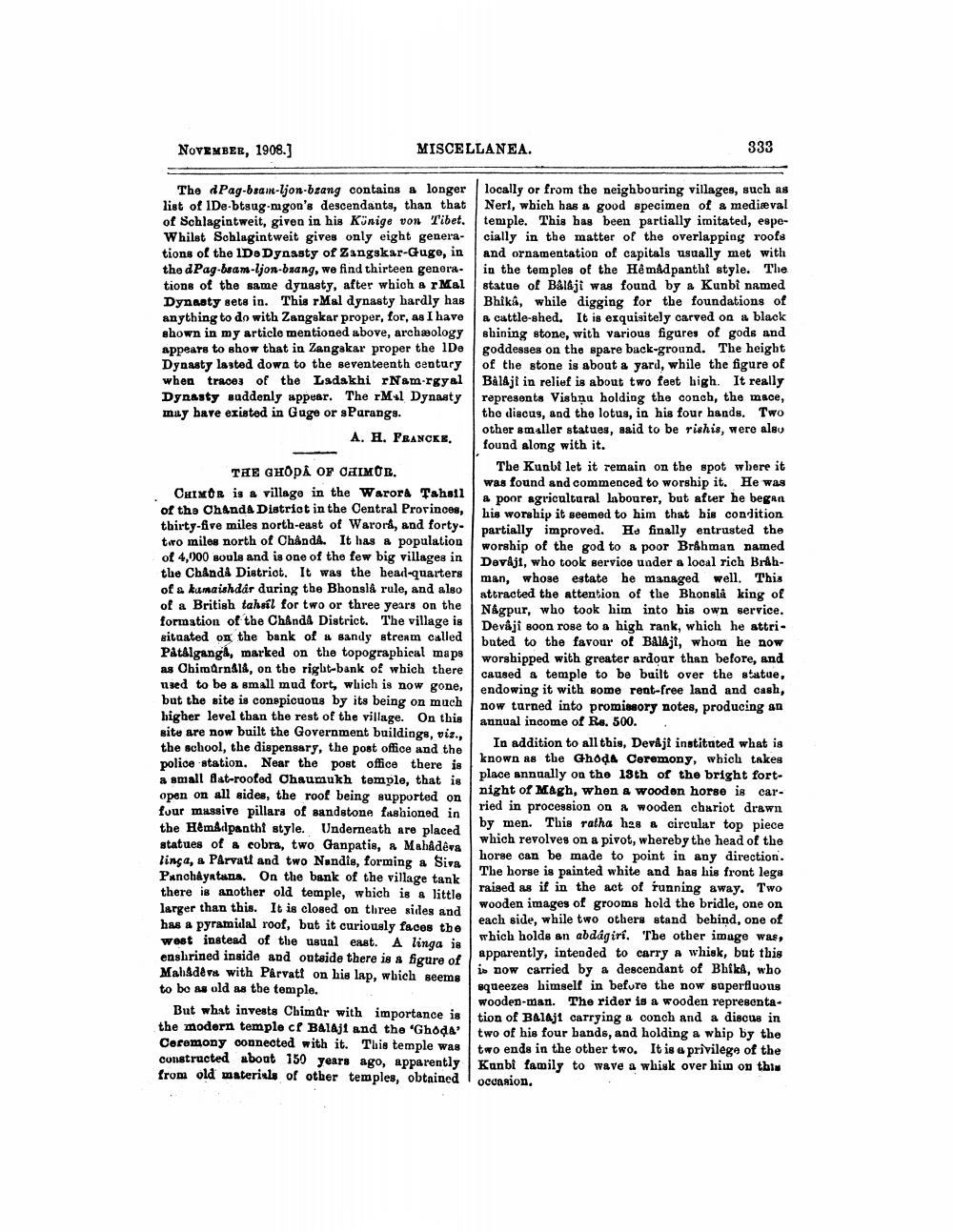________________
NOVEMBER, 1908.]
The dPag-beam-ljon-bzang contains a longer list of 1De-btsug-mgon's descendants, than that of Schlagintweit, given in his Könige von Tibet. Whilst Schlagintweit gives only eight generations of the IDe Dynasty of Zangskar-Guge, in the dPag-beam-ljon-baang, we find thirteen generations of the same dynasty, after which a rMal Dynasty sets in. This rMal dynasty hardly has anything to do with Zangskar proper, for, as I have shown in my article mentioned above, archæology appears to show that in Zangakar proper the 1De Dynasty lasted down to the seventeenth century when traces of the Ladakhi rNam-rgyal Dynasty suddenly appear. The rMal Dynasty may have existed in Guge or sPurangs.
A. H. FRANCKE,
MISCELLANEA.
THE GHODA OF CHIMUR.
CHIMOR is a village in the Warora Tahsil of the Chanda District in the Central Provinces, thirty-five miles north-east of Warord, and fortytwo miles north of Chanda. It has a population of 4,000 souls and is one of the few big villages in the Chânda District. It was the head-quarters of a kamaishdár during the Bhonsla rule, and also of a British tahsil for two or three years on the formation of the Chanda District. The village is situated on the bank of a sandy stream called Patalganga, marked on the topographical maps as Chimarnâlâ, on the right-bank of which there used to be a small mud fort, which is now gone, but the site is conspicuous by its being on much higher level than the rest of the village. On this site are now built the Government buildings, viz., the school, the dispensary, the post office and the police station. Near the post office there is a small flat-roofed Chaumukh temple, that is open on all sides, the roof being supported on four massive pillars of sandstone fashioned in the Hêmådpanthi style. Underneath are placed statues of a cobra, two Ganpatis, a Mahâdêva linga, a Parvati and two Nandis, forming a Siva Panchayatana. On the bank of the village tank there is another old temple, which is a little larger than this. It is closed on three sides and has a pyramidal roof, but it curiously faces the west instead of the usual east. A linga is enshrined inside and outside there is a figure of Mahadeva with Pârvat! on his lap, which seems to be as old as the temple.
But what invests Chimûr with importance is the modern temple cf Balaji and the 'Ghoda' Ceremony connected with it. This temple was constructed about 150 years ago, apparently from old materials of other temples, obtained
333
locally or from the neighbouring villages, such as Neri, which has a good specimen of a medieval temple. This has been partially imitated, especially in the matter of the overlapping roofs and ornamentation of capitals usually met with in the temples of the Hêmadpanthi style. The statue of Balaji was found by a Kunbi named Bhika, while digging for the foundations of a cattle-shed. It is exquisitely carved on a black shining stone, with various figures of gods and goddesses on the spare back-ground. The height of the stone is about a yard, while the figure of Balaji in relief is about two feet high. It really represents Vishnu holding the conch, the mace, the discus, and the lotus, in his four hands. Two other smaller statues, said to be rishis, were also found along with it.
The Kunbi let it remain on the spot where it was found and commenced to worship it. He was a poor agricultural labourer, but after he began his worship it seemed to him that his condition partially improved. He finally entrusted the worship of the god to a poor Brahman named Deviji, who took service under a local rich Bråhman, whose estate he managed well. This attracted the attention of the Bhonsla king of Nagpur, who took him into his own service. Devâji soon rose to a high rank, which he attributed to the favour of Balajt, whom he now worshipped with greater ardour than before, and caused a temple to be built over the statue, endowing it with some rent-free land and cash, now turned into promissory notes, producing an annual income of Rs. 500.
In addition to all this, Devâji instituted what is known as the Ghoda Ceremony, which takes place annually on the 13th of the bright fort
night of Magh, when a wooden horse is carried in procession on a wooden chariot drawn by men. This ratha has a circular top piece which revolves on a pivot, whereby the head of the horse can be made to point in any direction. The horse is painted white and has his front legs raised as if in the act of running away. Two wooden images of grooms hold the bridle, one on each side, while two others stand behind, one of which holds an abdagiri. The other image was, apparently, intended to carry a whisk, but this
is now carried by a descendant of Bhiks, who squeezes himself in before the now superfluous wooden-man. The rider is a wooden representation of Balaji carrying a conch and a discus in two of his four hands, and holding a whip by the two ends in the other two. It is a privilege of the Kunbi family to wave a whisk over him on this occasion.




